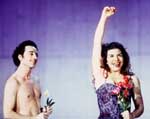
Michael Boyd’s Royal Shakespeare Company production of A Midsummer Night’s Dream (seen at BAM) was, as we say in Brooklyn, for the boids. It takes an ineffable combination of fecklessness, tastelessness, and mindlessness to turn this airiest of gossamer fantasies into a gigantic lead balloon that could, dropped from above, flatten out even the wooden head that conceived it. It was Peter Brook, a fine but deluded director, who in 1970 first mounted – under the influence of the baleful Polish theoretician Jan Kott – a Dream that was one part Beckett and three parts nonsense. Brook’s Athenian wood was a cross between a gymnasium and a loony bin, all magic and poetry banished. But at least Brook could direct and had talented actors. Not so Boyd.
He and his hapless designer begin with a raked platform that is indeed a wooden O, its rear half bordered by a drab wooden wall with five doors in it. The floor sports five trap doors for actors to emerge from incongruously, and numerous holes from which poppies can pop up too ludicrously to be lyrical. I was hoping that when the action shifted to the woods, the wall would revolve to reveal a modicum of enchantment. It remained the same, although some dry ice came crawling in through the doors, and a ladder rose from one of the manholes for Oberon to climb toward Titania’s bed suspended in mid-air – a steal from a previous British Dream seen here some years back. Later, the ladder sat there unretracted, its fourfold shadow cast on that arena wall on which some actor occasionally perched like a spectator at a corrida. But there was no bullfight, only bull.
As Boyd directed both the noble Athenians and the fairies to behave like louts, fishwives, or derelicts, the mechanicals (to whom he proclaims the play “a huge hymn of praise”) had to be turned, by contrast, into abject imbeciles, whose antics would have made the lowest mountebank retch. (A curious hymn of praise, that.) The one trump card director and players thought they had was bawdy. But what good is bawdy when its purveyors, from low to high, seem unfailingly recruited for their unsightliness, and act like overwrought underachievers or maundering bystanders?
As both Theseus and, identically except for something (seaweed? worms?) on his bald pate, Oberon, the colorless Nicholas Jones suggests a lesser Patrick Stewart, than which I know no fainter praise. As Hippolyta-Titania, the crude and Caribbean-accented, physically unappealing Josette Simon is about as regal as a jittery hand puppet. Puck and Peaseblossom, turned into randy lovers here, were played by actors as gifted and prepossessing as back-country bumpkins. The two Athenian couples were such as even their mothers would have been hard put to love, and the lesser players disappeared into the – yes – woodwork. This magical forest was a lumber yard, with the director the chief blockhead in it.
That the London critics praised this production is shocking enough; that the bam audiences became more and more noisily enraptured as the goings-on became more nauseating is word-beggaringly pitiful. This Dream came to us together with the news of the passing of John Gielgud; I don’t know which more clearly betokens the extinction of classical theater in England. (Well, there remain Trevor Nunn at the National and, lurking somewhere, Peter Hall.) In the 1660s, Samuel Pepys, without having experienced what Boyd wrought, called Dream in his diary “the most insipid, ridiculous play that ever I saw.” Now that’s what I call twenty-twenty foresight.